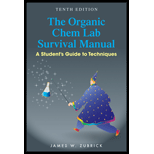
Concept explainers
Interpretation:
Phosphorouspentoxide is a heck of a drying agent but it is unsuitable for drying many liquids or solutions present in
Concept Introduction:
A drying agent is a chemical used to remove water from an organic compound that is in solution. Phosphorous pentoxide, magnesium sulfate, or potassium chloride etc., are used as drying agent.
Drying agentsare usually certain anhydrous salts that combine with water in the product and hold it as water of crystallization.
Answer to Problem 1E
Due to its exothermic nature and difficult to handle, it is unsuitable for drying many solutions present in organic chemistry laboratory.
Explanation of Solution
The molecular formula of Phosphorous pentoxide is
It is quicker and effective than sodium sulfate and magnesium sulfate in absorbing moisture because if dried an organic liquid with anhydrous sodium sulfate or magnesium sulfate alone, it leaves water in the organic liquid, even if it looks dry (not cloudy).
Though
Sulfuric acid and phosphorous pentoxide are both acidic drying agents that are mainly used in desiccators and not in direct contact with the solution since they are very aggressive reagents. Both have a very high capacity. Sulfuric acid forms hydrates while phosphorous pentoxide is ultimately converted into phosphoric acid.
When
This reaction is exothermic in nature as shown below:
Hence, due to its exothermic nature and difficult to handle, it is unsuitable for drying many solutions present in lab.
Want to see more full solutions like this?
Chapter 10 Solutions
The Organic Chem Lab Survival Manual: A Student's Guide to Techniques
- Considering the procedure below: “Determination of the concentration of HCl: Pipette 10 mL of hydrochloric acid and transfer to a 100 mL volumetric flask, complete the volume with water and homogenize. Remove a 10 mL aliquot of this solution and transfer it to a second dilution in a 100 mL volumetric flask, complete the volume with water and homogenize. Take a 20 mL aliquot of this last solution and transfer to a 250 mL erlenmeyr and add 20 mL of distilled water and 4 drops of the acid-base indicator. Titrate with a previously standardized 0.100 mol/L sodium hydroxide solution until the indicator turns.” Answer: a) In this titration, the indicator used is phenolphthalein. Discuss the use of this indicator considering its turning range and pH at the stoichiometric point of the titration. Justify. b) Considering that the volume of titrant used was equal to 24.5 mL, calculate the concentration of HCl in the sample in mol/L.arrow_forward1. Explain the importance of using a thermometer in the simple distillation setup. 2. Enumerate the characteristics of a substance for it to be separated from the heterogeneous mixture by steam distillation. 3. How does steam facilitate the distillation of essential oils? 4. Discuss some applications of simple distillation and steam distillation. Explain why you can use each method for the chosen application.arrow_forwardGive the advantages of using steam distillation in the recovery of an inorganic liquid from a mixture.arrow_forward
- What are the differences between a simple distillation and steam distillation?arrow_forwardWhat is the difference between the reaction of soap-water and synthetic detergent-water mixture to litmus papers?arrow_forwardWhat are the important solubility characteristics for a solvent for crystallization of an organic solid that is contaminated with a small amount of impurity?arrow_forward
- You wash a separatory funnel with soap and water to ensure it is clean before extracting an aqueous solution with dicholormethane. You should take the time to make sure there are no drops of water left inside the separatory funnel. Select an answer and submit. For keyboard navigation, use the up/down arrow keys to select an answer. a True Falsearrow_forwardPparrow_forwardCOMPLETE THE STATEMENT: 1. Before manufacturing process begins the sources of suitable fragrances are ______ in the manufacturing centre. 2. Oils are ______ from plants and other substances by several methods 3. During ________, flowers are spread on glass sheets coated with grease. 4. _________is the oldest and least complex method of extraction. 5. During Aging, the_____ tests whether the perfume has the specific smell or not.arrow_forward
- 3. Take another 10mL of the temporary hard water and boil for 5 minutes. Filter, then add 5 mL of soap solution to the filtrate and shake. What is the result? Is the water hard? Why is this type of harness called "temporary hardness"? What other substances cause temporary hardness? Write the equation for removal of temporary hardness by heating. Give 3 other methods of removing temporary hardness in water.arrow_forwardWhat is the function of a desiccant in a set-up of volatilization gravimetry? To remove nitrogen from the sample To remove sulfuric acid from the sample To remove water vapor from the sample To remove carbon dioxide from the samplearrow_forwardUsing the solubility information from your table of constants, make a flow chart, showing the procedure you would use to separate 4- chloroaniline from 1,4-dibromobenzene. Indicate what compound is in each solvent by writing the structures at the appropriate locations in the flow chart. please answer the question, and draw the chart.arrow_forward
 ChemistryChemistryISBN:9781305957404Author:Steven S. Zumdahl, Susan A. Zumdahl, Donald J. DeCostePublisher:Cengage Learning
ChemistryChemistryISBN:9781305957404Author:Steven S. Zumdahl, Susan A. Zumdahl, Donald J. DeCostePublisher:Cengage Learning ChemistryChemistryISBN:9781259911156Author:Raymond Chang Dr., Jason Overby ProfessorPublisher:McGraw-Hill Education
ChemistryChemistryISBN:9781259911156Author:Raymond Chang Dr., Jason Overby ProfessorPublisher:McGraw-Hill Education Principles of Instrumental AnalysisChemistryISBN:9781305577213Author:Douglas A. Skoog, F. James Holler, Stanley R. CrouchPublisher:Cengage Learning
Principles of Instrumental AnalysisChemistryISBN:9781305577213Author:Douglas A. Skoog, F. James Holler, Stanley R. CrouchPublisher:Cengage Learning Organic ChemistryChemistryISBN:9780078021558Author:Janice Gorzynski Smith Dr.Publisher:McGraw-Hill Education
Organic ChemistryChemistryISBN:9780078021558Author:Janice Gorzynski Smith Dr.Publisher:McGraw-Hill Education Chemistry: Principles and ReactionsChemistryISBN:9781305079373Author:William L. Masterton, Cecile N. HurleyPublisher:Cengage Learning
Chemistry: Principles and ReactionsChemistryISBN:9781305079373Author:William L. Masterton, Cecile N. HurleyPublisher:Cengage Learning Elementary Principles of Chemical Processes, Bind...ChemistryISBN:9781118431221Author:Richard M. Felder, Ronald W. Rousseau, Lisa G. BullardPublisher:WILEY
Elementary Principles of Chemical Processes, Bind...ChemistryISBN:9781118431221Author:Richard M. Felder, Ronald W. Rousseau, Lisa G. BullardPublisher:WILEY





